
A presentation from the FBI Cyber Division on current cyberterrorism and cyber espionage threats to the U.S. that was presented at the ISSA CISO Executive Forum in April 2015.
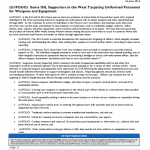
In the first half of 2015 there were at least two instances of Islamic State of Iraq and the Levant (ISIL) inspired individuals in the West expressing interest in targeting law enforcement (LE) to obtain weapons and other specialized gear through theft. As ISIL continues to exhort its individuals in the West to carry out attacks, the potential exists that some terrorists may use this tactic and attempt to steal weapons or issued items, such as credentials, badges, uniforms, radios, ballistic vests, vehicles, and other equipment, which could be used in furtherance of an attack. We note that laws governing the purchase of firearms differ widely among Western nations making this tactic more likely to occur in countries where laws are most restrictive and firearms are harder to obtain through legitimate means.

The Islamic State of Iraq and the Levant (ISIL) has become the preeminent terror group among U.S.-based extremists according to an assessment authored by the Department of Homeland Security and more than a dozen state and local fusion centers. Individuals determined to fight “overseas in a Muslim-majority country” or conduct attacks domestically will be “more likely to derive inspiration from ISIL than [al-Qaeda] or any of its affiliates” as long as ISIL can maintain its “current level of perceived legitimacy and relevancy.” This assessment of ISIL’s increasing popularity among domestic extremists is the focus of a ten page Field Analysis Report obtained by Public Intelligence titled Assessing ISIL’s Influence and Perceived Legitimacy in the Homeland: A State and Local Perspective. Drawing on suspicious activity reports from around the country as well as intelligence reporting from DHS and the Bureau of Prisons, the report finds that ISIL’s military successes in Iraq and Syria along with the group’s self-proclaimed re-establishment of the caliphate have captured the attention of violent extremists likely to buy in to its “violent extremist counterculture.”
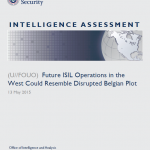
I&A assesses that the plot disrupted by Belgian authorities in January 2015 is the first instance in which a large group of terrorists possibly operating under ISIL direction has been discovered and may indicate the group has developed the capability to launch more complex operations in the West. We differentiate the complex, centrally planned plotting in Belgium from other, more-simplistic attacks by ISIL-inspired or directed individuals, which could occur with littleto no warning.
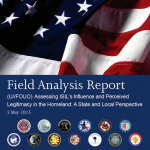
This Field Analysis Report (FAR) is designed to support awareness and inform enforcement and collection operations of federal, state, and local partners involved in homeland security and counterterrorism efforts. Some of the activities described in the FAR may be constitutionally protected activities and should be supported by additional facts to justify increased suspicion. The totality of relevant circumstances should be evaluated when considering any law enforcement response or action. Our assessment of the level of the Islamic State of Iraq and the Levant’s (ISIL) name recognition since its declaration of a caliphate in June 2014 is based on a review of suspicious activity reporting (SAR) across the United States between 1 January and 30 December 2014, criminal complaints of US persons charged with supporting or seeking to support ISIL, Bureau of Prisons (BOP) intelligence reporting, and DHS I&A open source reporting to assess the influence of ISIL’s messaging campaign within the United States and ISIL’s perceived legitimacy among homegrown violent extremists (HVEs).

The Islamic State of Iraq and the Levant (ISIL) has risen to prominence as a danger to peace and a regional threat with global impact. This perception comes, in large measure, because of its successes in Syria and then a rapid takeover of northern Iraq. Its military victories are largely due to successful recruiting, intra-insurgent conflict, large cash reserves, and ineffective opponents. There is much to learn from how ISIL is fighting. The ready availability of recruits, many of whom are foreigners attracted to ISIL successes, and large amounts of money for payroll and purchasing war materiel are critical considerations, but it is also important to consider how ISIL is fighting on the ground.

The “innovative use of social media and messaging” by the Islamic State of Iraq and the Levant (ISIL) “has played a key role in motivating young Western males and females to travel to the Syrian conflict to join and support the self-declared Islamic State” according to a join intelligence bulletin released by the Department of Homeland Security and FBI last month. The 5-page bulletin titled “ISIL Social Media Messaging Resonating with Western Youth” was disseminated to law enforcement throughout the country at the end of February to report on the “continuing trend” of Western youth being inspired to travel to Syria and join ISIL forces. According to the bulletin, this trend is aided by the fact that “Western youth are willing to connect over social media with like-minded persons, and have proven adept at obfuscating such social media usage from their parents and guardians.”

This Joint Intelligence Bulletin (JIB) is intended to provide information on a continuing trend of Western youth being inspired by Islamic State of Iraq and the Levant (ISIL) messaging via social media to travel to Syria to participate in the conflict. This JIB is provided to support the activities of FBI and DHS to assist federal, state, local, tribal, and territorial government counterterrorism and law enforcement officials and private sector security partners in deterring, preventing, or disrupting terrorist attacks in the United States.
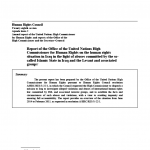
The present report has been prepared by the Office of the United Nations High Commissioner for Human Rights pursuant to Human Rights Council resolution A/HRC/RES/S-22/1, in which the Council requested the High Commissioner to dispatch a mission to Iraq to investigate alleged violations and abuses of international human rights law committed by ISIL and associated terrorist groups, and to establish the facts and circumstances of such abuses and violations, with a view to avoiding impunity and ensuring full accountability.
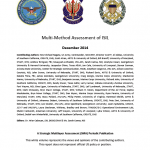
Early in 2014, as it became clear that the rise of the so-called “Islamic State” was becoming a significant menace to Regional Stability and US Interests, SOCCENT began a dialogue with Dr. Hriar Cabayan and his co-workers regarding a topic that has been at the core of the struggle against Violent Extremism. That question has been, and remains today, a perplexing one for those of us from Western cultures and societies: “What precisely are we contesting, and what is it that fuels the adversary’s power?” The contents of this paper reflect some of the work that Dr. Cabayan and his colleagues are doing to help us understand and comprehend this “intangible power” across a unique enterprise of academicians, scientists, policy intellectuals, current and former Foreign Service, military, and intelligence professionals. Most importantly, their efforts to improve our comprehension will enable us to adjust our efforts, our operations, our investments, and our risk-‐calculations to more effectively contest it and the organization that wields it. I am grateful for their tireless work in this regard, and I commend it to the reader.

An intelligence assessment released last month by the Department of Homeland Security’s Office of Intelligence and Analysis found that a domestic terrorist attack conducted by individuals affiliated with or inspired by the Islamic State of Iraq and the Levant (ISIL) would most likely “employ tactics involving edged weapons, small arms, or improvised explosive devices (IEDs).” The assessment, which was obtained by Public Intelligence, was released in October following several recent attacks conducted in Europe and Australia by individuals sympathetic to ISIL. Based on a review of these and other planned attacks, analysts at DHS evaluated the tactics and targets, as well as operational security measures employed in order to determine “tactics, targets, and tradecraft that potentially could be used in the Homeland by individuals associated with or inspired” by ISIL.
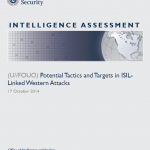
This Assessment highlights the tactics, targets, and tradecraft that potentially could be used in the Homeland by individuals associated with or inspired by the Islamic State of Iraq and the Levant (ISIL); we do not address the likelihood of an attack against the United States by the group. This Assessment is intended to support the activities of DHS to assist federal, state, and local government counterterrorism and law enforcement officials, first responders, and private sector security partners in effectively deterring, preventing, preempting, or responding to terrorist attacks against the United States.

The FBI Cyber Division has issued a notification to private industry and law enforcement to be aware of the potential for retaliatory cyber attacks following recent U.S. military actions in the Middle East. While the FBI has “no information at this time to indicate specific cyber threats to US networks or infrastructure in response to ongoing US military air strikes against the terrorist group known as the Islamic State of Iraq and the Levant (ISIL)” the bulletin states that the FBI believes that “extremist hackers and hacktivist groups, including but not limited to those aligned with the ISIL ideology, will continue to threaten and may attempt offensive cyber actions against the United States in response to perceived or actual US military operations in Iraq or Syria.”
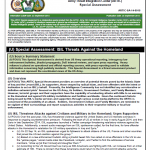
This ARTIC Special Assessment provides an overview of potential threats posed by the Islamic State of Iraq and the Levant (ISIL), its supporters, those swayed by radical Islam, and lone offenders with the intent or inclination to act on ISIL’s behalf. Presently, the Intelligence Community has not identified any corroborative or definitive extremist plots focused on the US Army, its Soldiers, Government Civilians, and Family Members. However, terrorist groups and their supporters have the capability of conducting attacks with little to no warning in the Homeland and against US military installations and facilities worldwide. Given the continued rhetoric being issued by ISIL’s media services and supporters through various social media platforms the ARTIC is concerned of the possibility of an attack. Soldiers, Government Civilians and Family Members are reminded to be vigilant of their surroundings and report suspicious activities to their respective military or local law enforcement.
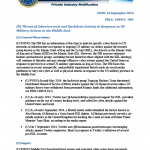
The FBI has no information at this time to indicate specific cyber threats to US networks or infrastructure in response to ongoing US military air strikes against the terrorist group known as the Islamic State of Iraq and the Levant (ISIL), also known as the Islamic State of Iraq and al-Shams (ISIS) or the Islamic State (IS). However, the FBI assesses extremist hackers and hacktivist groups, including but not limited to those aligned with the ISIL ideology, will continue to threaten and may attempt offensive cyber actions against the United States in response to perceived or actual US military operations in Iraq or Syria. The FBI bases this assessment on recent, nonspecific, and probably aspirational threats made on social media platforms to carry out cyber as well as physical attacks in response to the US military presence in the Middle East.